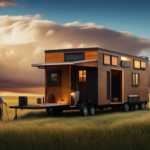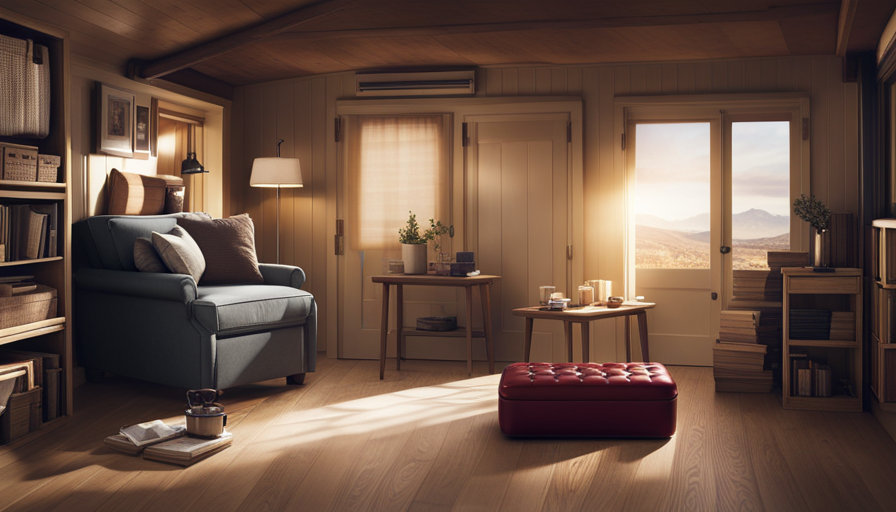Imagine driving down the open road, feeling the wind in your hair, and the excitement of starting a new adventure. Picture yourself pulling a tiny house from Kansas to the sunny shores of California.
It’s a journey that promises breathtaking landscapes, unforgettable memories, and the opportunity to create a home wherever you go. But before you embark on this epic road trip, it’s important to consider the logistics and costs involved.
In this article, we will explore the various factors that contribute to the overall cost of towing a tiny house from Kansas to California. From researching towing companies to calculating fuel expenses, we will provide you with the information you need to plan your journey and ensure a smooth and successful move.
So buckle up and get ready to hit the road – your tiny house adventure awaits!
Key Takeaways
- Towing a tiny house from Kansas to California offers adventure and the ability to create a home anywhere.
- Towing your tiny house gives you control but can be expensive and strain your vehicle.
- Alternative options like flatbed truck services or specialized trailers may be more cost-effective.
- Research and compare towing quotes for the most suitable and cost-effective option.
Research Towing Companies in Your Area
If you’re thinking about towing your tiny house from Kansas to California, it’s time to start researching some towing companies in your area. When it comes to towing a tiny house cross country, there are some important factors to consider.
Let’s discuss the pros and cons of this option.
One of the main advantages of towing your tiny house is that you have control over the entire process. You can choose the route, take breaks whenever you want, and ensure the safety of your belongings. Additionally, towing allows you to have your home with you at all times, providing a sense of familiarity and comfort during the journey.
However, there are also downsides to towing a tiny house long distances. First and foremost, it can be quite expensive. Towing companies charge based on the weight, size, and distance of the tow, so the costs can add up quickly. Moreover, towing a heavy load can put a strain on your vehicle and increase the risk of accidents on the road.
Before making a final decision, it’s worth exploring alternative options for transporting your tiny house. Some companies offer flatbed truck services or even specialized trailers designed specifically for tiny houses. These alternatives may provide a more cost-effective and efficient way to move your home.
Now that we’ve discussed the pros and cons of towing a tiny house cross country and explored alternative options, let’s move on to calculating the distance and fuel costs for your journey.
Calculate the Distance and Fuel Costs
To calculate the distance and fuel expenses, you’ll need to determine the total mileage and average fuel consumption for the journey. First, let’s calculate the distance from Kansas to California. According to Google Maps, the driving distance from Kansas City to Los Angeles is approximately 1,500 miles. However, since the exact starting and ending points in Kansas and California are not specified, it is important to factor in some additional miles for detours or unexpected routes.
Next, let’s estimate the fuel consumption for towing a tiny house. The average fuel consumption for towing a tiny house can vary depending on factors such as the weight of the house, weather conditions, and the type of vehicle used. On average, a truck towing a tiny house can get around 10-15 miles per gallon. Considering the distance of 1,500 miles, we can estimate that the fuel consumption would be around 100-150 gallons.
In addition to fuel costs, it is also important to consider toll costs along the way. Toll fees can vary depending on the specific route taken, but it is advisable to allocate some budget for this expense.
Now that we have calculated the distance and estimated fuel consumption, we can move on to the next step and consider the size and weight of your tiny house for a more accurate cost estimation.
Consider the Size and Weight of Your Tiny House
Once you determine the size and weight of your tiny house, you’ll gain a better understanding of the logistical considerations for your journey from Kansas to California. Research costs will play a significant role in your decision-making process.
The size of your tiny house will determine the type of equipment needed for towing. Smaller houses may require a standard flatbed trailer, while larger ones might require a specialized trailer with additional support. It is essential to research different towing options and their associated costs to find the most suitable and cost-effective solution for your tiny house.
Weight is another crucial factor to consider. Heavier tiny houses may require a stronger tow vehicle, which could increase fuel consumption and potentially add to the overall cost of the journey. Researching fuel consumption rates for different tow vehicles is essential to estimate the fuel costs accurately.
Determining the size and weight of your tiny house will help you research costs and make informed decisions about your cross-country journey. Once you have a clear understanding of these factors, you can proceed to the next step of determining if permits are required for cross-country travel.
Determine if Permits are Required for Cross-Country Travel
Determining whether permits are necessary for traveling cross-country can depend on various factors, such as the dimensions of your tiny home. Some states require permits for structures exceeding a certain height or width. Therefore, it’s crucial to research the permit requirements for transporting a tiny house before embarking on a journey from Kansas to California.
Researching permit requirements for tiny house transportation is essential to ensure compliance with the law. Each state has its own regulations, and understanding the legal restrictions for towing a tiny house across state lines is crucial to avoid any potential issues or penalties. Some states may require oversize load permits or special permits for structures that exceed certain dimensions.
To determine if permits are required for your specific tiny house, it’s recommended to contact the Department of Transportation or the relevant state agencies in both Kansas and California. They can provide you with detailed information about the permit requirements and any additional regulations you need to follow.
Once you have a clear understanding of the permit requirements, you can move on to the next step of getting quotes from towing companies.
Get Quotes from Towing Companies
Obtaining quotes from towing companies can help you understand the financial aspects of transporting your tiny home across state lines. Finding reliable towing companies is essential to ensure a smooth and efficient move. By reaching out to multiple companies, you can compare towing quotes and find the most cost-effective option for your needs.
To assist you in your research, I have created a table below that outlines five different towing companies and their estimated costs for transporting a tiny house from Kansas to California:
| Towing Company | Estimated Cost |
|---|---|
| Company A | $2,500 |
| Company B | $2,800 |
| Company C | $3,000 |
| Company D | $3,200 |
| Company E | $3,500 |
Please note that these are just estimates, and the actual cost may vary depending on various factors such as the size and weight of your tiny home, the distance traveled, and any additional services required.
Once you have obtained quotes from towing companies, it is important to factor in additional expenses such as insurance and storage. These costs can vary depending on your specific needs and circumstances. Considering these factors will give you a more accurate understanding of the total cost involved in transporting your tiny house.
In the next section, we will explore how to factor in additional expenses such as insurance and storage without compromising your budget.
Factor in Additional Expenses such as Insurance and Storage
Make sure to consider additional expenses like insurance and storage when planning to transport your tiny home across state lines. While the cost of towing your tiny house from Kansas to California is an important factor to consider, it’s equally important to factor in additional expenses that may arise during the process. Here are some key points to keep in mind:
-
Insurance coverage: It’s crucial to ensure that your tiny house is adequately insured during transportation. Contact your insurance provider to discuss the coverage options available for your specific situation. This will help protect your investment in case of any unforeseen accidents or damages that may occur during the journey.
-
Long-term storage options: If you’re not planning to move into your tiny house immediately upon arrival in California, you may need to consider long-term storage options. Research local storage facilities that can accommodate your tiny house and compare prices to find the most suitable option for your needs.
-
Additional permits and fees: Depending on the route you take and the specific regulations in each state, there may be additional permits or fees required for transporting your tiny house. Research the requirements of each state you’ll be passing through to avoid any surprises along the way.
-
Maintenance and repairs: It’s wise to set aside some funds for any necessary maintenance or repairs that may be needed after the long journey. This could include checking the tires, brakes, and other mechanical components to ensure your tiny house is in optimal condition.
Considering these additional expenses will help you plan your budget more accurately and avoid any unexpected financial burdens. Once you have a clear understanding of these factors, you can then move on to planning your route and accommodations for your journey to California.
Plan Your Route and Accommodations
Find the perfect scenic route and cozy accommodations along the way to make your cross-country tiny home journey an unforgettable adventure. Planning your route is essential to ensure a smooth and enjoyable trip. Consider the distance, road conditions, and any specific requirements for towing a tiny house. Research different routes and choose one that suits your preferences and needs.
In addition to planning your route, it’s important to budget for accommodations during the journey. Look for suitable parking spots where you can safely park your tiny house overnight. Some options include campgrounds, RV parks, and even certain hotels that offer designated parking spaces for larger vehicles. Be sure to factor in the cost of these accommodations when calculating your overall budget.
To emphasize the importance of planning your budget and finding suitable parking spots, consider the following table:
| Planning Your Budget | Finding Suitable Parking Spots | Ensuring Safety |
|---|---|---|
| Research costs of fuel, food, and accommodations | Look for campgrounds, RV parks, and hotels with designated spaces | Install safety measures such as wheel locks and hitch locks |
By planning your budget and finding suitable parking spots, you can minimize unexpected expenses and ensure a comfortable journey for your tiny home. As you prepare your tiny house for the journey, there are additional steps you should take to ensure its safety and stability.
Prepare Your Tiny House for the Journey
Before hitting the road, make sure your tiny home is as secure as a fortress, ready to withstand any bumps along the way. Proper maintenance is crucial to minimize road vibrations and keep your tiny house in top condition.
Here are a few key steps to prepare your tiny house for the journey:
-
Secure loose items: Remove any loose items inside your tiny house and secure them properly to prevent damage during transport. Consider using straps or bungee cords to keep everything in place.
-
Reinforce fragile components: Pay extra attention to fragile components such as windows, doors, and cabinets. Reinforce them with additional support or padding to minimize the risk of breakage.
-
Check tires and suspension: Ensure that your tiny house’s tires are properly inflated and in good condition. Also, check the suspension system to make sure it can handle the weight of your home and absorb road vibrations effectively.
-
Inspect the hitch: Thoroughly inspect and tighten the hitch connection to ensure a secure attachment to your towing vehicle.
Taking these steps will help ensure a smooth and safe journey for your tiny house. However, it’s important to be aware of potential challenges and risks that may arise along the way.
Be Aware of Potential Challenges and Risks
Now that your tiny house is ready for the journey, it’s important to be aware of the potential challenges and risks that may arise during the tow from Kansas to California. Despite careful planning and preparation, there are certain factors that can pose a threat to the safety of your tiny house and those on the road.
One of the main potential risks is the weather conditions along the route. From heavy rainstorms to strong winds, these elements can make towing a tiny house more difficult and increase the chances of accidents. Additionally, road conditions such as potholes or uneven surfaces can also contribute to the risks involved.
To mitigate these risks, it’s crucial to take safety precautions. This can include regularly checking the weather forecast along the route and adjusting your travel plans accordingly. It’s also important to drive at a safe and reasonable speed, allowing for ample braking distance and maintaining control of the tow vehicle.
In order to further visualize the potential challenges and risks, here is a table summarizing some of the main factors to consider:
| Potential Risks | Safety Precautions |
|---|---|
| Weather conditions | Check forecasts regularly and adjust travel plans accordingly |
| Road conditions | Drive at a safe speed, allowing for ample braking distance |
| Other drivers | Stay alert and maintain a safe distance from other vehicles |
By being aware of these potential risks and taking the necessary safety precautions, you can enjoy the adventure and arrive safely in California!
Enjoy the Adventure and Arrive Safely in California!
Embrace the journey and ensure your safe arrival in sunny California! Moving your tiny house across states can be an exciting adventure, but it’s important to be prepared for the road trip ahead.
Here are some adventure tips and considerations to keep in mind to make your journey as smooth as possible:
-
Plan your route: Research the best roads and highways to take from Kansas to California. Consider any restrictions or tolls that may apply to your tiny house.
-
Pack essentials: Make sure to bring all the necessary supplies for the road trip, including food, water, and emergency kits. Additionally, don’t forget to secure your belongings inside the tiny house to prevent any damage during transportation.
-
Budget for expenses: Road trips can incur various expenses such as fuel, accommodation, and meals. Calculate these costs in advance to avoid any surprises along the way.
-
Stay safe and rested: Take breaks during your journey to rest and stretch your legs. Fatigue can be dangerous, so ensure you’re well-rested before hitting the road.
By following these adventure tips and considering road trip expenses, you can enjoy the journey while ensuring a safe arrival in California. So buckle up, relax, and get ready to create lasting memories as you take your tiny house on an epic cross-country adventure.
Frequently Asked Questions
Are there any specific regulations or requirements for towing a tiny house across state lines?
There are specific regulations and towing requirements for towing a tiny house across state lines. It is important to research and comply with weight limits, trailer requirements, and any permits needed for the journey.
How long does it typically take to tow a tiny house from Kansas to California?
To prepare a tiny house for a long distance tow, it is essential to ensure it is securely attached to the towing vehicle, inspect tires and brakes, and remove any loose items. Tools and equipment needed include a trailer hitch, safety chains, and a brake controller.
Are there any restrictions on the type of vehicle that can tow a tiny house?
There are no restrictions on the type of vehicles that can tow a tiny house. However, it is important to consider the towing capacity of the vehicle to ensure a safe and efficient journey.
What are the potential risks or challenges involved in towing a tiny house such a long distance?
When towing a tiny house long distance, potential risks and challenges include increased fuel consumption, tire wear, and potential damage to the house. Recommended accommodations include regular maintenance and inspections. Parking options for tiny house owners may vary depending on local regulations.
Are there any recommended accommodations or parking options for tiny house owners traveling to California?
When traveling to California with a tiny house, it’s essential to consider accommodation options and parking availability. There are various RV parks, tiny house communities, and campgrounds that cater to tiny house owners throughout the state.
Conclusion
Well, after crunching the numbers and doing some research, it’s safe to say that towing a tiny house from Kansas to California won’t exactly be a bargain.
With the distance, fuel costs, permits, and the sheer size and weight of your tiny abode, you’re looking at a pretty penny. But hey, who needs a savings account when you’ve got a tiny house on wheels, right?
Just make sure you plan your route, get some quotes from towing companies, and brace yourself for potential challenges along the way.
Happy trails!
Hi, I’m Emma. I’m the Editor in Chief of Tiny House 43, a blog all about tiny houses. While tree houses are often associated with childhood, they can be the perfect adult retreat. They offer a cozy space to relax and unwind, surrounded by nature. And since they’re typically built on stilts or raised platforms, they offer stunning views that traditional homes simply can’t match. If you’re looking for a unique and romantic getaway, a tree house tiny house might just be the perfect option.
















